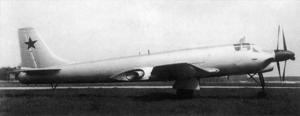Tupolev Tu-91
| Tu-91 | |
|---|---|

| |
| Role | Naval attack aircraft |
| National origin | Soviet Union |
| Manufacturer | Tupolev OKB |
| First flight | 17 May 1955 |
| Status | Prototype only |
| Number built | 2 |
The Tupolev Tu-91 (NATO reporting name Boot)[1] was a two-seat Soviet attack aircraft built during the 1950s. It was initially designed as a carrier-borne aircraft, but was converted into a land-based aircraft after Joseph Stalin's death in 1953 cancelled the aircraft carriers being designed. Two prototypes had been built and production had been approved by the Soviet Navy when it was inspected by the General Secretary, Nikita Khrushchev, in 1956. He remarked how ridiculous the Tu-91 looked and the program was cancelled.
Development
Following the end of
Kuznetsov had ordered preliminary design work to begin on the
The Tu-91 first flew on 17 May 1955,
Description
The Tu-91 was a
The crew of two sat side by side in a cockpit in the aircraft's nose, enclosed in an armour "bathtub" that consisted of 8-to-18-millimetre (0.3 to 0.7 in) ANBA-1 light alloy armour. All of the panels in the two
Specifications (Tu-91)
Data from The Osprey Encyclopedia of Russian Aircraft 1875–1995.[10]
General characteristics
- Crew: 2 (pilot and observer)
- Length: 17.7 m (58 ft 1 in)
- Wingspan: 16.4 m (53 ft 10 in)
- Height: 5.06 m (16 ft 7 in) [11]
- Wing area: 47.5 m2 (511 sq ft)
- Empty weight: 8,000 kg (17,637 lb)
- Max takeoff weight: 14,400 kg (31,747 lb)
- Powerplant: 1 × Kuznetsov TV-2M turboprop engine, 5,709 kW (7,656 hp)
- Propellers: 6-bladed contra-rotating propeller, 5.7 m (18 ft 8 in) diameter
Performance
- Maximum speed: 800 km/h (500 mph, 430 kn)
- Cruise speed: 250–300 km/h (160–190 mph, 130–160 kn)
- Range: 2,350 km (1,460 mi, 1,270 nmi)
- Service ceiling: 11,000 m (36,000 ft)
Armament
- Guns:
- 2 × 23 mm (0.91 in) NR-23cannon with 100 rounds each in wing roots
- 2 × 23 mm (0.91 in) NR-23 cannon with 150 rounds with in a tail turret
- 2 × 23 mm (0.91 in)
- Bombs: up to 1,500 kg (3,300 lb) of bombs, rockets or a single torpedo
See also
Aircraft of comparable role, configuration, and era
- Breguet Alizé
- Douglas A2D Skyshark
- Fairey Gannet
- Short Seamew
Related lists
Notes
Footnotes
- ^ a b Duffy & Kandalov, p. 112
- ^ Rohwer & Monakov, pp. 199–201
- ^ Rohwer & Monakov, pp. 216–217
- ^ a b Gunston 1995b, p. 423
- ^ Gordon & Rigmant, p. 147
- ^ a b c Gunston 1995a, p. 156
- ^ Gordon & Rigmant, p. 148
- ^ Duffy & Kandalov, pp. 112–113
- ^ Gunston 1995a, pp. 156–157
- ^ Gunston 1995b, p. 424
- ^ Duffy & Kandalov, pp. 209–210
Bibliography
- Duffy, Paul & Kandalov, Andrei (1996). Tupolev: The Man and His Aircraft. Shrewsbury, UK: Airlife. ISBN 1-85310-728-X.
- Gordon, Yefim & Rigmant, Vladimir (2005). OKB Tupolev: A History of the Design Bureau and its Aircraft. Hinckley, UK: Midland Publishing. ISBN 1-85780-214-4.
- Gunston, Bill (1995a). Tupolev Aircraft since 1922. Annapolis, Maryland: Naval Institute Press. ISBN 1-55750-882-8.
- Gunston, Bill (1995b). The Osprey Encyclopedia of Russian Aircraft 1875–1995. London: Osprey. ISBN 1-85532-405-9.
- ISBN 0-7146-4895-7.
Further reading
- Rigmant, V. I.; Saukke, M. V. & Soloviev, S. M. (April 1994). "Le Tupolev Tu-91: Il fut abondenné, victim d'un lapsus" [The Tupolev Tu-91: Abandoned Because of a Slip of the Tongue]. Le Fana de l'Aviation (in French) (293): 14–18. ISSN 0757-4169.
